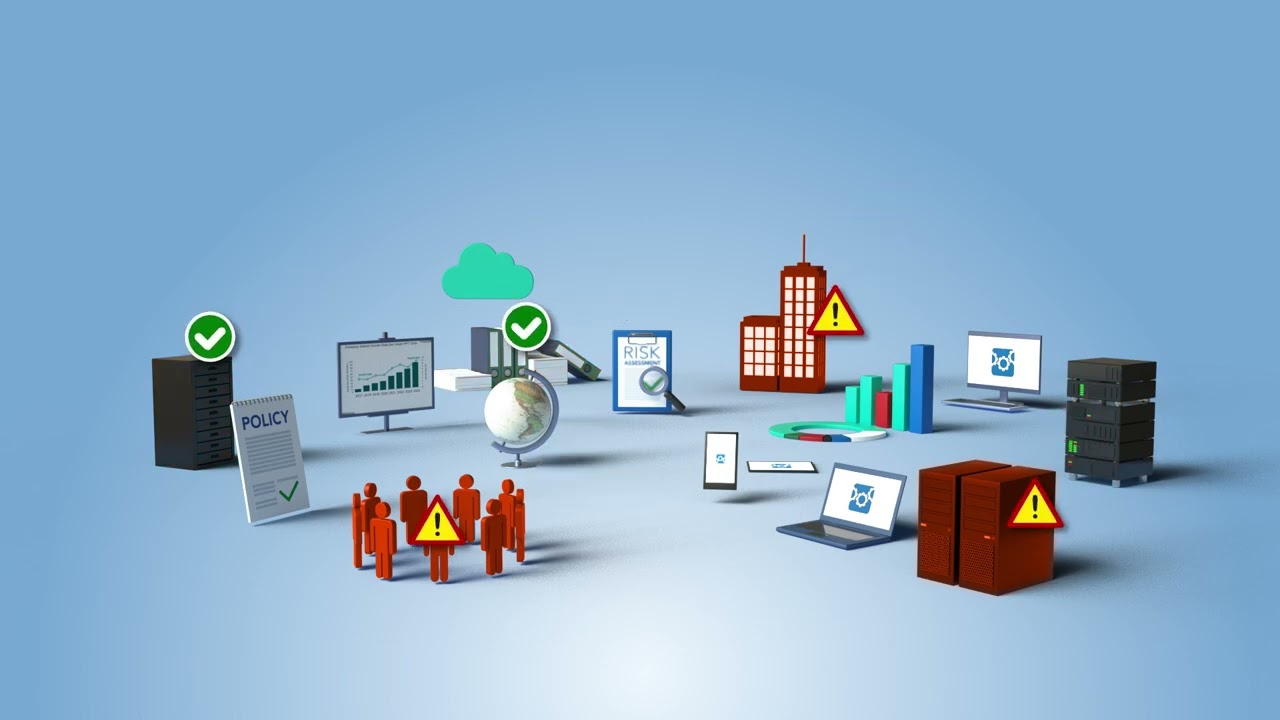Your Roadmap to Risk Reduction!
Table of Contents
ToggleThe Continuum GRC ITAM SaaS platform has hundreds of plugin modules available, such as:

SCA-V
The SCA-V, based on the NIST 800-53 attestation, is the most rigorous assessment available and provides the highest standard of attestation assurances to your customers.
Modules include:
- SCA-V System Security Plan (SSP)
- SCA-V Security Assessment Report (SAR)
- Federal Information Processing Standard (FIPS) 199 Categorization
- Plan of Action and Milestones (POA&M)
- SCA-V Preamble
- SCA-V Index
- AC Access Control
- AT Awareness and Training
- AU Audit and Accountability
- CA Certification, Accreditation, and Security Assessment
- CM Configuration Management
- CP Contingency Planning
- IA Identification and Authentication
- IR Incident Response
- MA Maintenance
- MP Media Protection
- PE Physical and Environmental Protection
- PL Planning
- PM Program Management
- PS Personnel Security
- PT Personally Identifiable Information Processing and Training
- RA Risk Assessment
- SA System and Services Acquisition
- SC System and Communications Protection
- SI System and Information Integrity
- SR Supply Chain Risk Management
Key Benefits & Features
Security Control Assessor-Validator (SCA-V) is a process that ensures that security controls in an IT system meet compliance standards for organizations that work with sensitive information or within regulated sectors. The assessment is designed to ensure that security measures meet established requirements, have been implemented correctly, and are operating as they should.
Validating these security controls through a risk assessment and compliance auditing helps improve an organization’s security posture and better protect data. It’s a vital part of risk management and is needed to achieve an Authority to Operate (ATO), required for working with government systems.
Why Choose Us
Continuum GRC is a trusted expert in the particular compliance issues around SCA-V. We also offer the services that may be needed to meet these high standards of security. We’re experienced in conducting assessments and audits to help your organization become compliant.
We know that adhering to these regulations and standards may seem overwhelming, but our risk management and certification professionals streamline the process. We’ll help with the appropriate scanning, testing, and validation of your networks, applications, and systems to ensure that they’re operating correctly. Continuum GRC will get you through the compliance process faster.
FAQ
Why is SCA-V important for cybersecurity compliance?
SCA-V is essential for cybersecurity compliance because it ensures that the information systems are in line with industry best practices and regulations. A compliance audit checks that the security controls were implemented correctly, and are working as they should. This helps organizations proactively minimize risk and data breaches.
How does SCA-V differ from traditional vulnerability scanning?
They are both cybersecurity practices. SCA-V seeks out vulnerabilities in software components, especially open-source software. It gives a comprehensive look at security risks around third-party code. Traditional vulnerability scanning looks for weaknesses in a wide range of networks, applications, and systems.
Who requires SCA-V assessments?
Any Department of Defense customer or contractor with systems or applications that require an Authority to Operate (ATO) – whether it’s being applied for or is expiring – needs this standardized control assessment to achieve compliance. The assessment will ensure that their software is secure.
Is SCA-V required for RMF compliance?
Yes. The comprehensive assessment of security controls that makes up SCA-V is an essential part of the Risk Management Framework (RMF). The services provided by SCA-V demonstrate security compliance with RMF in organizations working with information in sensitive government sectors.
What does SCA-V encompass?
SCA-V evaluates and validates security controls around specific cybersecurity standards and regulations. This includes checking that they’re properly implemented and operating as they should be. It also ensures that the controls are effectively mitigating threats around sensitive data from high-level government agencies.
How does SCA-V improve vulnerability management?
It strengthens an organization’s cybersecurity posture with a comprehensive approach to the security around third-party and open source components within software applications. Through automated scans, it detects vulnerabilities and outdated frameworks which might lead to other gaps. It also recommends and prioritizes fixes.
What are you waiting for?
You are just a conversation away from putting the power of Continuum GRC to work for you.
Contact us using the form below or calling us at 1-888-896-6207 for immediate assistance.
To reduce spam submissions, we’ve implemented email verification for access to this form.
How it works:
- Enter your email address below.
- We'll send you a unique verification link.
- Click the link in the email to confirm your identity and gain access to the form.
This ensures only verified users can proceed, helping keep responses genuine and spam-free.
Thank you for your cooperation! If you don't receive the email, check your spam folder or request a new link. If you prefer to speak with a REAL HUMAN, please call our number listed at the top of this page.
If you are seeing this message and not the intake form, you still need to validate your email address.
If you have received this message in error, please contact us using the telephone number listed on our website for assistance.
About the Standard
A compliance overview of NIST 800-53 Security Control Assessor-Validator (SCA-V) focused audits involves understanding the role, processes, and requirements of these audits within the context of the NIST Special Publication (SP) 800-53 framework and the broader Risk Management Framework (RMF). Below is a concise yet comprehensive overview, aligned with the provided context and focused on clarity:
Overview of NIST 800-53 SCA-V Audits
NIST SP 800-53, "Security and Privacy Controls for Information Systems and Organizations," provides a catalog of security and privacy controls for federal information systems and organizations. SCA-V audits are specialized assessments conducted by Security Control Assessors (SCAs) or Validators to evaluate the effectiveness of these controls in meeting compliance requirements, particularly for systems seeking an Authorization to Operate (ATO). These audits are critical for organizations handling sensitive data, especially those working with the U.S. Department of Defense (DoD) or other federal entities, to ensure compliance with frameworks like the RMF, FISMA, DFARS, NIST 800-171, and CMMC.
Key Components of SCA-V Audits
- Role of the Security Control Assessor-Validator (SCA-V):
- Definition: An SCA-V is an individual, group, or organization responsible for conducting independent, comprehensive assessments of management, operational, and technical security controls within an IT system to determine their effectiveness, as defined in NIST SP 800-37 (RMF).
- Independence: SCA-Vs are typically third-party assessors (e.g., accredited 3PAOs) or certified internal assessors under standards like NSTISSI 4015, ensuring objectivity.
- Objective: Verify and validate that security controls are implemented correctly, operate as intended, and meet compliance standards to mitigate risks and protect sensitive data.
- Scope of SCA-V Audits:
- Control Assessment: SCA-V audits assess controls outlined in NIST SP 800-53 (and its assessment procedures in SP 800-53A), covering areas like access control, audit and accountability, incident response, risk assessment, and system integrity.
- System Security Plan (SSP): Auditors review the SSP to ensure it accurately documents the system’s security controls and aligns with NIST 800-53 requirements.
- Security Categorization: Systems are categorized based on the CIA triad (Confidentiality, Integrity, Availability) per FIPS 199 and CNSSI 1253 to determine applicable controls (Low, Moderate, or High impact).
- Assessment Methods: Audits involve interviews, examination, and testing to verify control implementation and effectiveness, as outlined in NIST SP 800-53A.
- Compliance Frameworks:
- NIST 800-53: The core standard for federal systems, defining controls to protect information systems.
- RMF (NIST SP 800-37): SCA-V audits are integral to the RMF process, supporting steps like control selection, implementation, assessment, and authorization.
- FISMA: Ensures federal agencies comply with cybersecurity requirements through annual assessments and continuous monitoring.
- DFARS NIST 800-171 and CMMC: Relevant for DoD contractors, requiring SCA-V audits to validate controls for protecting Controlled Unclassified Information (CUI).
- Other Standards: May include compliance with NIST 800-34 (Contingency Planning), CNSSI 1253, and ICD 503 for specific contexts.
- Audit Process:
- Preparation: Develop a Security Assessment Plan (SAP) outlining the scope, methodology, and controls to be tested.
- Execution: Conduct assessments using NIST SP 800-53A procedures, including:
- Interviews: Engage with system owners and personnel.
- Examination: Review documentation (e.g., SSP, policies).
- Testing: Perform technical tests (e.g., vulnerability scans, penetration testing).
- Reporting: Produce a Security Assessment Report (SAR) detailing findings, vulnerabilities, and compliance status.
- Plan of Action and Milestones (POA&M): Document identified weaknesses and remediation plans.
- ATO Support: Provide evidence for the Authorizing Official to grant or renew an ATO, typically valid for three years.
- Key Requirements:
- Accreditation: Third-party assessors (3PAOs) must be accredited, often under A2LA ISO/IEC 17020 standards.
- Certifications: SCA-V professionals should hold certifications like CISSP, CISA, or CISM to demonstrate expertise.
- Continuous Monitoring: Audits support ongoing monitoring to maintain compliance between formal assessments (every three years or as required).
- Security Clearances: Assessors may need clearances for systems handling sensitive data.
- Documentation: Comprehensive records, including SSP, SAR, and POA&M, are critical for audit success and ATO approval.
- Outcomes and Benefits:
- Risk Reduction: Identifies and mitigates vulnerabilities to enhance system security.
- Compliance Assurance: Ensures adherence to federal regulations, enabling organizations to operate in regulated environments.
- ATO Achievement: Validates controls for ATO approval, critical for DoD or federal contracts.
- Enhanced Security Posture: Proposes enhancements to address gaps, such as new controls or policy updates.
Critical Considerations
- Challenges: The complexity of NIST 800-53 controls (over 1,000 in Revision 5) requires deep expertise and robust tools for effective assessment. Automated tools, like those described in NISTIR 8011, can streamline testing by breaking controls into granular “control items.”
- Customization: Audits must be tailored to the organization’s risk profile, system categorization, and operational context.
- Evolving Standards: Assessors must stay updated with revisions to NIST standards (e.g., SP 800-53 Rev. 5) and emerging threats.
- Third-Party vs. Internal: Organizations can use accredited 3PAOs (e.g., Lazarus Alliance) or certified internal assessors, depending on requirements.
Conclusion
SCA-V audits are a cornerstone of cybersecurity compliance for federal and DoD-related systems, ensuring that NIST 800-53 controls are effectively implemented to protect sensitive information. By following a structured process—categorization, control selection, assessment, reporting, and remediation—these audits support risk management, compliance with RMF and FISMA, and the achievement of ATOs. Organizations benefit from partnering with experienced, certified assessors and leveraging tools like Continuum GRC’s ITAM platform to streamline compliance.

